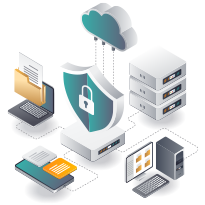 Understanding Cyber Security and End Point Detection & Response (EDR)
Understanding Cyber Security and End Point Detection & Response (EDR)
Cyber security is the practice of protecting computer systems, networks, and data by using a variety of different strategies and tools. Cyber security must be constantly monitored to minimize risk to business resources and assets.
Application Security
Application security refers to the different software tools businesses use to complete their daily tasks. Often, the developers of applications are responsible for addressing any security vulnerabilities. However, the businesses that use them are also responsible for installing all updates as they become available. Otherwise, a cybercriminal would be able to exploit weaknesses and gain access to sensitive information.
Information Security
Information security refers to an organization’s data. Businesses use a wide range of tools in addition to policies that are enacted to maintain information security. These policies address the technical measures that guard data internally as well as the security measures that protect the physical location where the data is stored.
Network Security
Network security refers to the hardware and software that are used to create a corporate network. It works hand in hand with endpoint security to prevent unauthorized access to and/or misuse of the devices and applications on an organization’s network.
Network security often involves three phases:
- Protection: refers to the configuration of network settings as well as those of each device or application on the network.
- Detection: refers to the constant monitoring of network activity to identify anomalies and concerning patterns.
- Response: refers to the procedures and automated reactions that address potential issues.
Network security tools include vulnerability scanning applications, virtual private networks (VPNs) identity and access management (IAM) software, as well as analytics tools.
Endpoint Security
Endpoint security refers to all the end user devices that exist on a corporate network. The most common endpoints include smartphones, laptops, desktops, and tablets. They are the largest threat to cyber security since they are the most difficult to monitor. Endpoint security solutions include endpoint protection platforms (EPPs) and endpoint detection and response (EDR) software.
Internet Security
Internet security refers to platforms that are accessed through the internet and the devices that use the internet to complete certain responsibilities. Internet security tools include antivirus software, password managers, and firewalls.
More about Endpoint Detection and response (EDR):
Endpoint Detection and Response (EDR) is a technology that provides non-stop monitoring and response to advanced cybersecurity threats both against networks and systems. Endpoint Detection Response is a subset of endpoint security, which monitors a corporate network and its data when employees access the network remotely via laptops, smartphones, and other mobile devices. Because these assets are at the end of the chain that connects a user to the company’s technology, they are referred to as endpoints.
